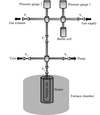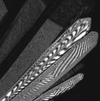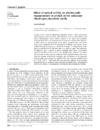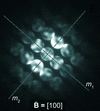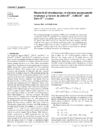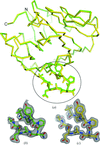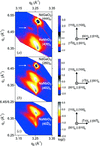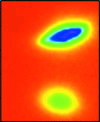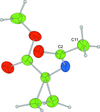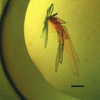issue contents
October 2012 issue

Cover illustration: Example of a three-dimensional reciprocal-space map recorded from a sample of GaAs nanowires grown on GaAs. Courtesy of Schlepütz et al. [J. Appl. Cryst. (2011), 44, 73-83].
research papers
The results of small-angle and ultra-small-angle X-ray scattering on porous CaCO3 microparticles of pulverulent vaterite made by a conventional chemical route and by using supercritical CO2 are presented.
Source misalignment effects on the crystal effective scattering area, the diffracted X-ray intensity profile on the crystal surface and the collection solid angle of a nearly exact point-focusing crystal geometry are investigated.
Neutron powder diffraction patterns of TiV1.2Mn0.8 were collected in situ during hydrogenation at 373 K, using a simple-design copper-coated vanadium can.
A single-shot methodology to derive an average coating thickness in multi-particle core–shell systems exhibiting a high X-ray absorption is presented. This approach is based on X-ray nanotomography and high-energy X-ray diffraction.
Download citation


Download citation


The growth of 1,5-diphenylpenta-2,4-dien-1-one single crystals by the condensation of an ethanol solution and characterization studies are reported. Multiple peaks indicate an internal structural low-angle boundary.
CCDC reference: 856740
Highly stoichiometric AgInSe2 thin films have been prepared on a p-type Si(111) substrate by a sol–gel spin-coating technique for the first time, for promising photovoltaic applications.
Residual strains in a stabilized zirconia layer are measured from the macroscale to the nanoscale using X-ray and electron diffraction. A detailed description of the experiments is given and results at three different scales are compared and discussed.
Possibilities of applying confocal microscopy on an X-ray beamline have been explored. Confocal microscopy images have the potential to give detailed, on-axis and three-dimensional views of protein crystals on a synchrotron beamline.
Download citation


Download citation


The microstrain broadening in X-ray diffraction patterns of polycrystalline Fe3C powder particles prepared at and cooled from 873 K to ambient measuring temperature is pronouncedly anisotropic. The broadening can be quantitatively interpreted as being caused by thermal microstresses as a result of the anisotropic thermal shrinkage in conjunction with the elastic anisotropy of Fe3C.
The contribution of the natural optical activity and electrogyration effects to measurements of the linear, quadratic and fourth-order electro-optic coefficients in crystals of the potassium dihydrogen phosphate family is theoretically analyzed. The results obtained indicate that the contribution is negligible compared to the resolution of previously reported experimental data; however, the situation may change after improving the resolution by one order of magnitude.
The appearance of a bulk Cu–(In,Sn) intermetallic phase was observed in a metal matrix composite based on Cu–Al–Ni shape-memory alloys. Its crystal structure was carefully investigated using a transmission electron microscope by applying diffraction techniques based on the analysis of the symmetry and the relative positions of reflections in the zero- and high-order Laue zones.
The electron paramagnetic resonance g-factor formulas are constructed for ZnSe:Ti2+, CdTe:Ti2+ and ZnSe:V3+ crystals based on the contributions of the charge-transfer levels and the spin-orbit coupling effect of the central ion and the ligands. The g factors are calculated from these formulas, and the calculated values agree well with the experimental ones.
The influence of poly(acrylic acid) on apatite nanocrystal formation is investigated using a new in situ X-ray scattering cell that affords highly precise temperature control.
Synchrotron X-ray Laue microdiffraction is used to investigate the microstructure of deformed quartz. The unambiguous indexing of the Laue diffraction pattern can only be achieved by taking the intensities of the diffraction peaks into account.
In order to take advantage of the new capabilities of the High Flux Isotope Reactor at Oak Ridge National Laboratory, a 40 m-long small-angle neutron scattering instrument has been constructed. The design and characteristics of this instrument are described, along with examples of scattering data to illustrate the performance.
Counter-diffusion crystallization using a new capillary crystallization format (CrystalHarp) is described. It allows low-temperature in situ diffraction data collection and is applicable for the novel high-pressure vitrification method, which allows data collection without the addition of cryoprotectant.
The defects in tetragonal hen egg-white lysozyme crystals were characterized by digital X-ray topography using an X-ray CCD camera and conventional X-ray topography using X-ray film.
Piezoelectric NaNbO3 thin films with differing crystal symmetries and orientations were epitaxially grown on various oxide substrates by the liquid-delivery spin metal–organic chemical vapour deposition method. High-resolution X-ray diffraction proved that the phase formation of NaNbO3 thin films is critically driven by the strain status within the films, which can be controlled by tuning the lattice mismatch (sign and magnitude) between the films and the substrates.
The first results from polarized neutron diffraction experiments on a time-of-flight instrument at a spallation source are reported. Higher neutron beam flux and efficient spin polarization at the neutron beamline enable in situ studies of phenomena contributing to field-induced magnetization in materials including magnetic shape memory alloys.
Lithium tantalate crystals with varying Li2O content have been produced by vapour transport equilibration and show the formation of wedge-shaped domains for compositions where the birefringence is close to zero. Measurements of the birefringence coupled with Raman scattering experiments have enabled precise determination of Li2O concentration.
Grazing-incidence small-angle X-ray scattering (GISAXS) has been used to structurally characterize model hard and soft gratings of nanotechnological interest. The different gratings exhibit GISAXS patterns with characteristic features that can be associated with their level of order along the direction of periodicity and the length of the lines.
High-speed three-dimensional reciprocal-space mapping during molecular beam epitaxy growth of InGaAs
A high-speed three-dimensional reciprocal-space mapping method has been developed and commissioned for real-time monitoring of the strain relaxation process during the growth of heterostructure semiconductors. Using this method, the strain relaxation process of InGaAs heteroepitaxial films grown on GaAs(001) has been investigated.
computer programs
3DBVSMAPPER is a program that generates bond-valence sum maps and bond-valence energy landscapes with a given test ion. The program is capable of running in parallel and automatically loads, processes and analyses crystallographic information files.
Variants of the traditional Waser geometric restraints which are appropriate for the modelling of large globular or extended linear structures are described.
laboratory notes
A method for reproducible manual formation of nanolitre protein crystallization drops in high-throughput format is described. The method saves precious protein material without sacrificing the effectiveness of the screening process, can produce diffraction-quality crystals and is easily adoptable by ordinary crystallography laboratories.
Open  access
access
 access
accessThe effect of coupling the salt concentration gradient crystallization method with the use of the paramagnetic salt MnCl2 and a magnetic field is reported. The use of a simple magnetic device is shown to have a significant effect on hen egg-white lysozyme crystal growth.


 journal menu
journal menu










